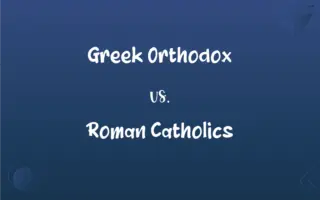XML vs. JSON: What's the Difference?
Edited by Janet White || By Harlon Moss || Updated on October 16, 2023
XML is markup for document encoding, JSON is lightweight data-interchange format.

Key Differences
XML, or Extensible Markup Language, is a markup language that defines a set of rules for encoding documents in a format that is both human-readable and machine-readable, while JSON, or JavaScript Object Notation, is a lightweight data-interchange format that is easy for humans to read and write, and for machines to parse and generate.
XML is heavily used in web publishing to display data on the web, and its design focuses on documents, with the full breadth of features required for complex, hierarchical document structures, whereas JSON is primarily used to transmit data between a server and web application, as an alternative to XML.
XML data is known for its custom tags and stringent parsing, requiring each opened tag to be closed, offering robustness in data storage and transmission, while JSON, with its data-structure approach, employs key-value pairs for its attributes, providing flexibility and efficiency.
In XML, attributes cannot contain multiple values (everything is string-based); conversely, JSON values can be arrays or objects, allowing for a complex, nested data structure using arrays and records.
XML's syntax is considered verbose compared to JSON, which has a simpler syntax, making JSON more efficient for data interchange in web applications, particularly in today's modern web environments.
ADVERTISEMENT
Comparison Chart
Data Type
String-based content
Multiple types: number, string, boolean
Verbose
More verbose, with opening and closing tags
Less verbose, simplified syntax
Data Structure
Hierarchical with attributes
Nested with arrays and objects
Parsing
Stringent, must be well-formed
Lenient, easily broken
Use Case
Document-centric applications
Data interchange, especially in web apps
ADVERTISEMENT
XML and JSON Definitions
XML
EXtensible Markup Language.
That webpage uses XML for its news feed syndication.
JSON
Uses human-readable text to transmit data objects.
JSON's readability makes debugging much easier for developers.
XML
A standard for documents containing structured information.
XML is perfect for preserving the structure in our document archives.
JSON
JavaScript Object Notation.
The server sends responses in JSON, which our web app parses easily.
XML
Defines rules for encoding documents in a human/machine-readable format.
Check the XML document for any encoding errors before we proceed.
JSON
Structures data as key-value pairs.
The settings for the application are stored in a JSON file for easy updates.
XML
A text-based format used to encapsulate data.
We'll need to convert this XML file to import the data correctly.
JSON
Lightweight format for storing and transporting data.
For the mobile app's data exchange, JSON is more efficient due to its size.
XML
A platform-independent data format.
Our systems communicate through XML, ensuring compatibility regardless of the platform.
JSON
A data interchange format based on a subset of JavaScript.
Although called JavaScript Object Notation, JSON is language-independent.
XML
An international standard metalanguage for creating markup languages that structure digital information in a way that allows for the exchange, display, and storage of data independent of proprietary operating systems and hardware devices.
FAQs
Can XML support array data types?
No, XML doesn't natively support array data types; it encapsulates data in a string format.
What is XML?
XML is a markup language that encodes documents in a format both human and machine-readable.
Is JSON only applicable to JavaScript?
No, JSON is language-independent, despite its name suggesting a tie to JavaScript.
What does JSON stand for?
JSON stands for JavaScript Object Notation.
Is parsing XML files complex?
It can be, as XML requires strict, well-formed structures and syntax.
What's the primary purpose of XML?
XML is primarily used for storing and transporting data, especially in document-centric environments.
Are there security concerns with XML?
Yes, XML is prone to attacks like XML Injection if not properly handled.
Are XML files easily readable by humans?
Yes, XML files are human-readable due to their clear, attribute-structured format.
What makes JSON efficient for web data interchange?
Its lightweight, text-based format and ability to represent complex structures make JSON efficient for data interchange.
Are JSON files secure?
JSON itself doesn't ensure security, but data can be secured through encryption, secure protocols, and careful programming.
Why is XML considered verbose?
XML requires opening/closing tags, which increases the amount of text in files.
Is JSON used for data interchange only?
Primarily, but JSON is also used for storing data due to its accessibility and structure.
Can JSON represent hierarchical data structures?
Yes, JSON can represent complex, nested data structures using arrays and objects.
Why is JSON popular in web applications?
JSON is popular due to its ease of use, efficiency, and the fact that it's lightweight.
Do XML and JSON require different parsers?
Yes, XML and JSON data formats are different and require different methods to parse.
Is JSON more efficient than XML in web applications?
Generally, yes, because JSON has a simpler format and smaller size.
How does JSON handle data types?
JSON supports various data types, including number, string, boolean, array, and object.
Can I use XML for web configuration files?
Yes, XML is commonly used for configuration files due to its structure and readability.
Does XML support custom tags?
Yes, XML allows the creation of custom tags for personalized data structuring.
How does JSON improve server-client interactions?
JSON improves interactions by simplifying data interchange, parsing, and reducing data size.
About Author
Written by
Harlon MossHarlon is a seasoned quality moderator and accomplished content writer for Difference Wiki. An alumnus of the prestigious University of California, he earned his degree in Computer Science. Leveraging his academic background, Harlon brings a meticulous and informed perspective to his work, ensuring content accuracy and excellence.
Edited by
Janet WhiteJanet White has been an esteemed writer and blogger for Difference Wiki. Holding a Master's degree in Science and Medical Journalism from the prestigious Boston University, she has consistently demonstrated her expertise and passion for her field. When she's not immersed in her work, Janet relishes her time exercising, delving into a good book, and cherishing moments with friends and family.







































































